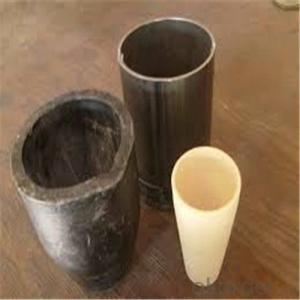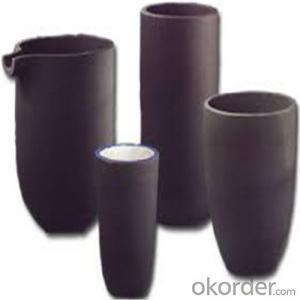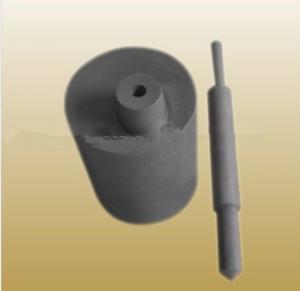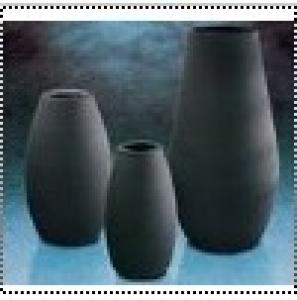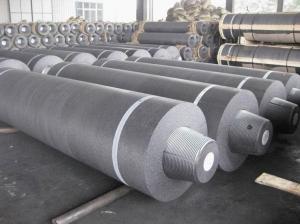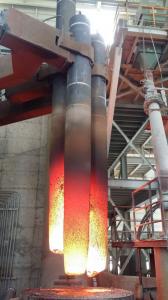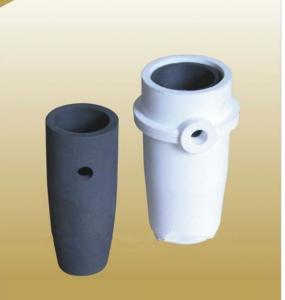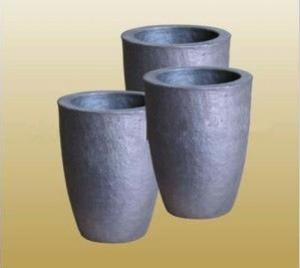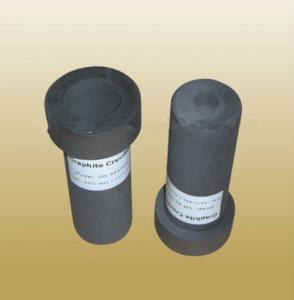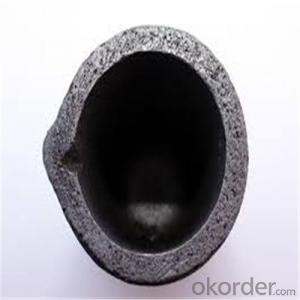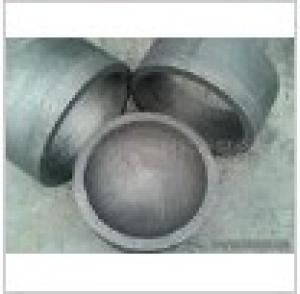SiC Graphite Crucibles For Melting Aluminium And Copper, Brass 2015
- Loading Port:
- Shanghai
- Payment Terms:
- TT OR LC
- Min Order Qty:
- 1 pc
- Supply Capability:
- 1000 pc/month
OKorder Service Pledge
OKorder Financial Service
You Might Also Like
Quick Details for SiC Graphite Crucibles For Gold, Melting Aluminium And Copper, Brass
| Type: | High Strength, graphite crucible crucible | Application: | melting metal | Height: | as your requirements |
| Composition: | High Pure | Top Diameter: | 10-600mm | Bottom Diameter: | 10-1000mm |
| Place of Origin: | China (Mainland) | Brand Name: | Model Number: | ||
| Color: | Black grey | Si3N4%: | 5min | Fe2O3%: | 0.7max |
| C%: | 30-45 | Apparent porosity: | 30max | Refractoriness: | 1680 |
| Bulk Density: | 1.71min | Using life: | >5000 hours | MAX temperature: | 1600c |
Packaging & Delivery
| Packaging Details: | Seaworty packing or as per customer's detail requirement of graphite crucible. |
| Delivery Detail: | within 20-30 days after confirm order of graphite cru |
SiC Graphite Crucibles For Melting Aluminium And Copper, Brass
Product Description
Specifications for Graphite Silicon Carbide Crucible For Aluminum Melting :
1.Long working lifetime: its working lifetime is increased 3-5 times over normal clay-crucible due to the compact body formed under high pressure.
2.High thermal conductivity: high-density body and low apparent porosity greatly improve its heat conductivity.
3.New-style materials: new heat conduction material ensures faster heat conductivity and pollution-free product, reduces adherent slag.
4.Resistance to corrosion:better anti-corrosion than normal clay-crucible.
5.Resistance to oxidation: advanced process dramatically improves its oxidation resistance, which ensures persistent heat conductivity and long working lifetime.
6.High-strength: high-density body and logical structure make the product better compression property.
7.Eco-friendly: energy-efficient and pollution-free, not only ensure metal product purity, but also ensure sustainable development on environment.
8.Multi-function: Can be used in induction graphite crucible furnace
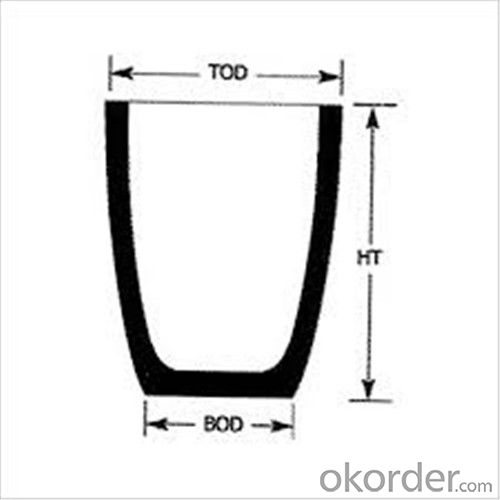

Physicochemical Properties of graphite crucible:
The crucible is an utensil or melting tank vessels that is made of refractory material (such as clay, graphite, quartz or difficult molten metal iron, etc.).
Graphite crucible, with is special advantages and Plasticity, is widely used in the smelting area, e.g. gold smelting, silver smelting, aluminum smelting, cooper smelting, etc.
high pure graphite | ||||
Item | Unit | baked twice | baked three time | baked four times |
impregnated once | impregnated twice | impregnated three times | ||
grain size | mm | ≤325μm | ≤325μm | ≤325μm |
Bulk density | g/cm3 | ≥1.68 | ≥1.78 | ≥1.85 |
Specific resistance | μΩ.m | ≤14 | ≤14 | ≤13 |
Bending strength | MPa | ≥25 | ≥40 | ≥45 |
Compressive strength | MPa | ≥50 | ≥60 | ≥65 |
Ash content | % | ≤0.15 | ≤0.1 | ≤0.05 |
Fine-grain Specialty Graphite FXG-1 | Fine-grain Specialty Graphite FXG-2 | ||||
Item | Unit | Guarantee value | Typical value | Guarantee value | Typical value |
Max grain size | mm | 0.8 | 0.8 | 0.8 | 0.8 |
Bulk density | g/cm3 | ≥1.70 | 1.73 | ≥1.73 | 1.76 |
Specific resistance | μΩ.m | ≤8.5 | 7.5 | ≤8.0 | 7 |
Bending strength | MPa | ≥10.0 | 11 | ≥12.0 | 12.5 |
Compressive strength | MPa | ≥24.0 | 27 | ≥31.0 | 34 |
Thermal Condcutivity | W/(m.k) | ≥120 | 150 | ≥130 | 160 |
C.T.E.(100-600) °C | 10-6/°C | ≤2.5 | 2.2 | ≤2.5 | 2.1 |
Ash content | % | ≤0.3 | 0.09 | ≤0.3 | 0.09 |
NO | Top diameter | Bottom diameter | Height | Tolerance | Capacity(Kg5%) |
2 | 90 | 50 | 55 | 2 | 0.3 |
3 | 105 | 80 | 93 | 2 | 0.5 |
4 | 102 | 80 | 100 | 2 | 0.6 |
5 | 112 | 82 | 130 | 2 | 0.8 |
6 | 120 | 82 | 141 | 2 | 0.9 |
8 | 138 | 90 | 153 | 2 | 1.2 |
12 | 148 | 100 | 181 | 2 | 1.8 |
16 | 156 | 110 | 190 | 2 | 2.3 |
20 | 180 | 120 | 230 | 2 | 3 |
25 | 186 | 128 | 248 | 2 | 3.7 |
- Q:Graphite and diamond are elemental elements made of carbon. Why are physical properties so different?
- Purpose: GraphiteIn the metallurgical industry, used in the manufacture of graphite crucible and foundry mold surface coating and furnace lining and protective slag;Electrical industry, do electrodes, brushes, batteries, positive conductive materials, carbon tubes and so on;In the chemical industry, it is used as catalyst material for acid and alkali products and chemical fertilizer industry, as well as high temperature resistant and high pressure seals;In addition, it can also be used as lubricant, anticorrosive paint, pigment, pencil core, gunpowder, neutron reduction agent in atomic reactor and anti corrosion agent in aerospace industry
- Q:Graphite crucible heat resistance, then graphite crucible can ignite? Charcoal is mainly composed of graphite, why charcoal can be ignited?
- Is not the same as the graphite crystal transition in carbon charcoal, but amorphous carbon, no C-C covalent bond. Charcoal ignition point is 320-370 DEG C, the general fire than the high temperature, so the charcoal can be ignited.
- Q:Are there any specific cleaning agents or methods recommended for graphite crucibles?
- There exist specific cleaning agents and techniques that are suggested for the purpose of cleaning graphite crucibles. Graphite crucibles are commonly employed in applications involving high temperatures, such as metal melting, and they can accumulate various impurities over time. A commonly suggested approach to clean graphite crucibles involves a combination of mechanical cleaning and chemical treatment. In mechanical cleaning, a soft brush or cloth is utilized to eliminate any solid debris or residue from the crucible. It is important to avoid using abrasive materials or engaging in harsh scrubbing, as this may result in damage to the crucible. Following mechanical cleaning, a chemical treatment is often required to remove any remaining impurities. Acidic solutions, for example hydrochloric acid or sulfuric acid, are frequently employed in the process of cleaning graphite crucibles. These solutions possess the capability to dissolve and eliminate organic and inorganic contaminants. However, it is crucial to be aware that handling and working with acid solutions can be hazardous and necessitates caution. It is recommended to wear personal protective equipment, such as gloves and goggles, and ensure adequate ventilation. Furthermore, it is of utmost importance to adhere to the manufacturer's instructions and guidelines for cleaning graphite crucibles. Certain crucibles may have specific requirements or limitations with regards to cleaning methods and agents, and it is vital to comply with these recommendations to prevent any damage to the crucible. In conclusion, while there are specific cleaning agents and techniques that are recommended for graphite crucibles, it is vital to exercise caution, follow safety guidelines, and consult the manufacturer's instructions to ensure proper cleaning and maintenance of the crucible.
- Q:Can graphite crucibles be used for ceramic production?
- No, graphite crucibles cannot be used for ceramic production. Ceramic production requires crucibles made from materials like alumina or zirconia, which can withstand high temperatures and provide a stable environment for the ceramic materials. Graphite crucibles are generally used for high-temperature applications involving metals and alloys.
- Q:In the melting of aluminum alloys, what is the frequency furnace and the crucible type furnace? I heard that the frequency furnace power is lower, faster and more power saving
- Medium frequency electric furnace will save a lot of electricity. Medium frequency electric furnace is also placed inside the graphite crucible, copper melting.The last time I saw a foundry over there in Anhui, where the crucible was used to smelt copper, the three or four furnace had to be replaced with a crucible.
- Q:Are graphite crucibles suitable for use in a vacuum environment?
- Graphite crucibles are indeed appropriate for utilization in a vacuum setting. Graphite, being an exceptionally stable substance, has the ability to endure elevated temperatures and corrosive surroundings. Consequently, it is extensively favored in various industrial applications, including those within vacuum environments. Notably, graphite crucibles possess outstanding thermal conductivity and resistance to thermal shock, both of which are crucial attributes for upholding temperature stability in a vacuum. Moreover, graphite exhibits low outgassing properties, signifying that it releases negligible amounts of gas or vapor when subjected to a vacuum. This further enhances its suitability for employment in such environments. All in all, graphite crucibles emerge as a dependable and efficient alternative for conducting experiments or processes in vacuum conditions.
- Q:Can a graphite crucible be used for nickel melting?
- Yes, a graphite crucible can be used for nickel melting. Graphite is a suitable material for high-temperature applications and has good resistance to chemical reactions with nickel. It can withstand the high temperatures required for nickel melting without melting or reacting with the metal, making it an ideal choice for this purpose.
- Q:Can a graphite crucible be used for powder injection molding?
- Yes, a graphite crucible can be used for powder injection molding. Graphite is a popular choice for crucibles in various high-temperature applications due to its excellent thermal conductivity, high melting point, and low chemical reactivity. In powder injection molding, a graphite crucible can withstand the high temperatures required for the process, typically ranging from 1300 to 1600 degrees Celsius. Additionally, graphite crucibles provide good resistance to thermal shock and can effectively contain the molten feedstock during the injection molding process. Overall, using a graphite crucible in powder injection molding is a suitable option due to its favorable characteristics and compatibility with the required operating conditions.
- Q:Can a graphite crucible be used for titanium melting?
- It is not possible to use a graphite crucible for melting titanium. The melting point of titanium is extremely high, reaching 1,668 degrees Celsius (3,034 degrees Fahrenheit), surpassing the maximum temperature capability of graphite, which is approximately 3,000 degrees Celsius or 5,432 degrees Fahrenheit. Consequently, if a graphite crucible were employed for titanium melting, the crucible would degrade and potentially pollute the titanium. In lieu of this, a crucible composed of materials like zirconium or ceramic should be utilized for titanium melting, as they can endure the elevated temperatures necessary for the procedure.
- Q:Can graphite crucibles be used for electron beam melting processes?
- Graphite crucibles are indeed capable of being used in electron beam melting processes. They possess exceptional thermal conductivity, a high melting point, and commendable resistance to chemical attack, rendering them appropriate for high-temperature applications like electron beam melting. The remarkable thermal conductivity of graphite aids in the effective transfer of heat, thereby enabling uniform heating and melting of the material. Moreover, graphite crucibles exhibit excellent dimensional stability, a vital factor in ensuring precise control over the melting process. Consequently, graphite crucibles are widely favored in electron beam melting processes due to their advantageous attributes.
1. Manufacturer Overview |
|
|---|---|
| Location | |
| Year Established | |
| Annual Output Value | |
| Main Markets | |
| Company Certifications | |
2. Manufacturer Certificates |
|
|---|---|
| a) Certification Name | |
| Range | |
| Reference | |
| Validity Period | |
3. Manufacturer Capability |
|
|---|---|
| a)Trade Capacity | |
| Nearest Port | |
| Export Percentage | |
| No.of Employees in Trade Department | |
| Language Spoken: | |
| b)Factory Information | |
| Factory Size: | |
| No. of Production Lines | |
| Contract Manufacturing | |
| Product Price Range | |
Send your message to us
SiC Graphite Crucibles For Melting Aluminium And Copper, Brass 2015
- Loading Port:
- Shanghai
- Payment Terms:
- TT OR LC
- Min Order Qty:
- 1 pc
- Supply Capability:
- 1000 pc/month
OKorder Service Pledge
OKorder Financial Service
Similar products
New products
Hot products
Related keywords

